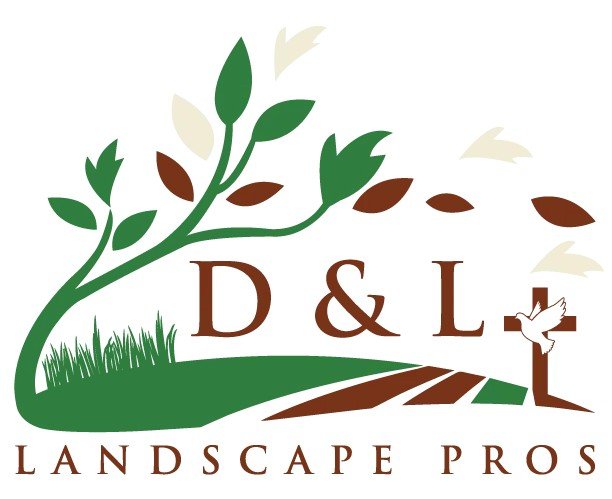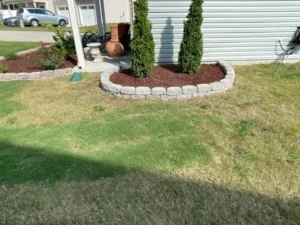
As the seasons change and temperatures drop, homeowners in South Charlotte, Matthews, Waxhaw, and Indian Trail often wonder how to prepare their landscapes for fall and winter. One of the most effective and simple ways to protect your plants, improve soil health, and keep your lawn looking great is mulching.
At D & L Landscape Pros, we specialize in professional mulching services that not only enhance the appearance of your yard but also provide long-term benefits for plant and lawn health. In this guide, we’ll explain why fall is the perfect time to mulch, the benefits of mulching, the types of mulch you can use, and expert tips for proper installation and maintenance.
Why Fall Is the Perfect Time to Mulch
While mulching can be done year-round, fall offers unique advantages for both your plants and lawn:
- Protection from Cold Temperatures
- Mulch acts as an insulating layer, helping protect roots from frost and extreme temperature swings.
- For young plants and newly planted shrubs, this insulation is especially critical.
- Mulch acts as an insulating layer, helping protect roots from frost and extreme temperature swings.
- Soil Moisture Retention
- Fall can be drier in some parts of North Carolina. Mulch helps retain soil moisture, reducing stress on trees, shrubs, and perennials.
- Fall can be drier in some parts of North Carolina. Mulch helps retain soil moisture, reducing stress on trees, shrubs, and perennials.
- Weed Prevention
- Mulching in fall can suppress weed growth during the cool season, preventing unwanted competition for nutrients.
- Mulching in fall can suppress weed growth during the cool season, preventing unwanted competition for nutrients.
- Improved Soil Health
- Organic mulches break down over time, adding nutrients and improving soil structure. Fall mulching gives the soil time to enrich before spring planting.
- Organic mulches break down over time, adding nutrients and improving soil structure. Fall mulching gives the soil time to enrich before spring planting.
- Enhanced Curb Appeal
- Fresh mulch immediately gives garden beds a neat, polished appearance, which is especially appreciated as homeowners prepare their yards for the holiday season.
- Fresh mulch immediately gives garden beds a neat, polished appearance, which is especially appreciated as homeowners prepare their yards for the holiday season.
The Benefits of Mulching in Detail
1. Temperature Regulation
Mulch acts like a natural blanket for the soil. In North Carolina, where winter temperatures can fluctuate dramatically, this insulation:
- Protects plant roots from freezing.
- Reduces stress on evergreen shrubs that remain active through winter.
- Helps maintain a consistent soil temperature, preventing repeated freeze-thaw cycles that can damage roots.
2. Moisture Retention
Even dormant plants need adequate soil moisture. Mulch helps:
- Reduce evaporation, keeping soil consistently damp.
- Prevent water stress for shrubs, perennials, and ornamental grasses.
- Improve survival rates for newly planted trees and shrubs.
3. Weed Suppression
Weeds compete with plants for water and nutrients. Fall mulching:
- Blocks sunlight from reaching weed seeds, reducing germination.
- Minimizes manual weeding in early spring, saving time and effort.
4. Soil Improvement
Organic mulches like shredded bark, wood chips, or leaf mulch decompose over time, enriching the soil by:
- Adding organic matter and nutrients.
- Improving soil structure and drainage.
- Supporting beneficial microorganisms that promote plant health.
5. Protection Against Lawn Stress
Mulching around trees and shrubs prevents lawn mower and trimmer damage by creating a defined buffer zone. It also reduces compaction around the root zone, allowing grass and plants to thrive.
Types of Mulch to Use in North Carolina
Choosing the right mulch is key to maximizing benefits. Here are common options for fall landscaping in South Charlotte and surrounding areas:
1. Shredded Bark
- Appearance: Dark, uniform color.
- Benefits: Long-lasting, natural-looking, breaks down slowly to enrich soil.
- Best for: Flower beds, shrubs, and around trees.
2. Wood Chips
- Appearance: Chunky texture, natural aesthetic.
- Benefits: Reduces erosion, insulates soil, breaks down slowly.
- Best for: Garden paths, larger shrubs, and ornamental trees.
3. Pine Straw
- Appearance: Golden straw-like texture, great for Southern gardens.
- Benefits: Excellent for acid-loving plants, lightweight, easy to spread.
- Best for: Azaleas, camellias, hollies, and other native shrubs.
4. Leaf Mulch/Compost
- Appearance: Varies depending on leaf type.
- Benefits: Adds nutrients, improves soil texture, inexpensive if using local leaves.
- Best for: Vegetable gardens, flower beds, and areas where nutrient addition is a priority.
How to Mulch Properly in Fall
Even the best mulch won’t help if it’s applied incorrectly. Follow these professional tips from D & L Landscape Pros:
1. Clear the Area
- Remove weeds, debris, and old mulch before applying new material.
- This ensures proper contact with soil and maximizes benefits.
2. Apply the Right Depth
- For most organic mulches, 2–3 inches is ideal.
- Too thin: won’t insulate or retain moisture effectively.
- Too thick: can prevent water and air from reaching roots, causing rot.
3. Keep Mulch Away from Plant Crowns
- Avoid piling mulch directly against tree trunks or shrub stems.
- This prevents rot, pest infestations, and fungal growth.
4. Spread Evenly
- Use a rake to create a smooth, uniform layer.
- Avoid compacting mulch; it should remain loose to allow water and air to penetrate.
5. Maintain Mulch Through Winter
- Check beds occasionally to ensure mulch hasn’t been displaced by wind or heavy rain.
- Replenish as needed to maintain the 2–3 inch layer.
Benefits of Hiring a Professional for Fall Mulching
While homeowners can mulch themselves, working with D & L Landscape Pros offers significant advantages:
- Expert Selection – We recommend the right type of mulch for your soil, plants, and aesthetic goals.
- Efficient Installation – Our team applies mulch at the correct depth, keeping plants safe and soil healthy.
- Time Savings – Mulching large beds or multiple areas can be labor-intensive; we do it quickly and efficiently.
- Seasonal Planning – We combine mulching with other fall landscape services like aeration, pruning, and leaf cleanup for maximum yard health.
Professional mulching ensures your landscape not only looks great now but is prepared to survive winter and thrive in spring.
Common Mulching Mistakes to Avoid
Even simple mulching can go wrong if these mistakes are made:
- Over-Mulching – Too thick can suffocate roots and retain excess moisture, leading to rot.
- Mulching Against Stems or Trunks – Causes fungal disease and invites pests.
- Using Inappropriate Mulch – Some mulches can alter soil pH or not provide enough insulation.
- Neglecting Bed Preparation – Applying over weeds or debris reduces effectiveness.
- Failing to Replenish – Organic mulch decomposes; a neglected bed loses protective benefits over winter.
Avoiding these mistakes ensures your fall mulch continues to benefit your lawn and plants through the season.
Final Thoughts
Fall mulching is more than just a cosmetic enhancement—it’s a critical step in preparing your South Charlotte, Matthews, Waxhaw, or Indian Trail yard for winter. From protecting roots against frost to improving soil health and preventing weeds, mulching has a wide range of benefits that last well into spring.
By applying mulch properly and choosing the right type for your plants, you create a healthy, low-maintenance landscape that is better equipped to withstand the winter months.
For homeowners who want the best results with minimal effort, professional mulching services from D & L Landscape Pros are the ideal solution. We provide expert plant care, mulching, and seasonal maintenance designed to keep your yard thriving year-round.
Call us today to schedule a fall mulching service and protect your lawn and plants while enhancing your landscape’s beauty this season!




